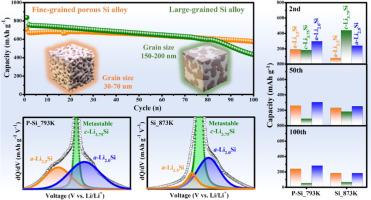控制晶粒设计抑制硅合金阳极亚稳相
IF 9.3
1区 材料科学
Q1 MATERIALS SCIENCE, MULTIDISCIPLINARY
引用次数: 0
摘要
由于高容量微尺度硅(Si)阳极颗粒在循环过程中具有巨大的体积变化和快速的结构退化,因此在坚固的基体(如碳、合金)中使用具有纳米级硅晶粒的颗粒是可取的。然而,控制纳米Si晶粒仍然是至关重要的,以防止大Si纳米晶粒完全锂化过程中产生的反应亚稳c-Li3.75Si相的有害影响。在此,我们提出了一种可扩展的晶粒控制(~ 60 nm)硅合金阳极,通过平衡路径合成,即非晶合金在特定温度下通过熔融纺丝技术合成的再结晶。优化后的纳米颗粒通过减轻c-Li3.75Si亚稳相,在控制反应相方面发挥了至关重要的作用。此外,通过酸性蚀刻得到了细粒的多孔结构。多孔性不仅可以作为改善动力学参数的标准,而且酸性蚀刻还可以通过去除非活性金属间相来增加容量,从而增加活性Si含量。因此,细晶多孔硅合金阳极提供了稳定的循环性能(在100次循环中达到~ 99.9%的库仑效率)。此外,差分容量(dQ/dV)与电压曲线作为c-Li3.75Si反应相循环时容量衰减的定量指标。该研究为基于晶粒调控的硅合金阳极的合理设计提供了重要见解,并拓宽了其他硅基阳极材料的研究策略。本文章由计算机程序翻译,如有差异,请以英文原文为准。

Suppressing Metastable Phase in Si Alloy Anodes via Controlled Grain Design
Due to the enormous volume variation and rapid structure degradation of high-capacity microscale silicon (Si) anode particles upon cycling, it is preferable to utilize the class of particles with nano-sized Si grains in the robust matrixes (e.g., carbon, alloy). However, it is still crucial to control nano-Si grains to prevent the detrimental effect from the reaction metastable c-Li3.75Si phase generated during the full lithiation of larger Si nanograins. Herein, we present a scalable grain-controlled (∼60 nm) Si alloy anode synthesized by equilibrium path, namely, recrystallization of the amorphous alloy at a specific temperature synthesized via melt-spinning technique. The optimized nanograins played a vital role in controlling the reaction phases by mitigating the metastable c-Li3.75Si phase. Furthermore, fine-grained porous structure is obtained by acidic etching. The porous nature not only acts as a criterion to improve the kinetic parameters but acidic etching also increases capacity by removing inactive intermetallic phases, thereby enriching the active Si content. Consequently, the fine-grained porous Si alloy anode provides a stable cycling performance (reaching ∼99.9% Coulombic efficiency over 100 cycles). In addition, differential capacity (dQ/dV) vs. voltage profiles were served as a quantitative indicator of capacity fading upon cycling for the c-Li3.75Si reaction phase. This research provides important insights into the rational design of Si alloy anodes based on grain regulation and broadens research strategies for other Si-based anode materials.
求助全文
通过发布文献求助,成功后即可免费获取论文全文。
去求助
来源期刊

Acta Materialia
工程技术-材料科学:综合
CiteScore
16.10
自引率
8.50%
发文量
801
审稿时长
53 days
期刊介绍:
Acta Materialia serves as a platform for publishing full-length, original papers and commissioned overviews that contribute to a profound understanding of the correlation between the processing, structure, and properties of inorganic materials. The journal seeks papers with high impact potential or those that significantly propel the field forward. The scope includes the atomic and molecular arrangements, chemical and electronic structures, and microstructure of materials, focusing on their mechanical or functional behavior across all length scales, including nanostructures.
 求助内容:
求助内容: 应助结果提醒方式:
应助结果提醒方式:


